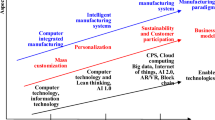Abstract
Supervisory control and data acquisition (SCADA) software which is suitable to distributed control systems is a demand for system developers because the characteristics of existing SCADA software packages are hard to satisfy the requirements of distributed systems. For the strengths of component-oriented techniques, this paper proposes a component-oriented architecture of SCADA software to satisfy the demand of distributed control systems. Design pattern and OPC (OLE for Process Control) technology are also used to make the openness for the architecture.
Similar content being viewed by others
References
Y. Serizawa et al., “Conceptual design for distributed real-time computer network architecture,” Proc. of IEEE PES Transmission and Distribution Conference, vol. 1, pp. 26–31, 2002.
J. Lowy, Programming.NET Components, p. 648, O’Reilly, 2005.
B. Douglass, Real-time Design Patterns Robust Scalable Architecture for Real-time Systems, pp. 125–130, Wesley, 2002.
A. Wang and K. Qian, Component Oriented Programming, p. 319, Wiley, 2005.
Siemens, WinCC v6 Getting Started Manual, 2003.
Wonderware, Intouch HMI Concepts and Capabilities Guide, 2007.
Advantech, GeniDAQ User’s Manual, 2000.
E. Gamma, R. Helm, R. Johnson, and J. Vlissides, Design Patterns, Elements of Reusable Objectoriented Software, Addison-Wesley, 1995.
J. Bishop, C# 3.0 Design Patterns, p. 290, O’Reilly, 2007.
T. D. Chau and N. N. Khai, “Web-based data monitoring and supervisory control,” Proc. of the Int. Conference ISEE, 2007.
K. Hamilton and R. Miles, Learning UML 2.0, p. 286, O’Reilly, 2006.
W. P. Junior and C. E. Pereira, “A supervisory tool for real-time industrial automation systems,” Proc. of the Sixth IEEE International Symposium on Object-Oriented Real-Time Distributed Computing, 2003.
B. Atlagic, “Application development environment of an integrated SCADA system,” Proc. of EUROCON 2003, Computer as a Tool, The IEEE Region 8, vol. 1, pp. 322–326, 2003.
F. Moscato, N. Mazzocca, and V. Vittorini, “Workflow principles applied to multi-solution analysis of dependable distributed systems,” Proc. of the 12th Euromicro Conference on Parallel, Distributed and Network-Based Processing, 2004.
Z. Ling and J. Yu, “The design of SCADA based on industrial ethernet,” Proc. of the 4th World Congress on Intelligent Control and Automation, 2002.
J. Zhang and Y. Zhang, “Component-oriented modeling and design of hierarchical hybrid control system,” Proc. of IEEE International Conference on Control and Automation, Guangzhou, China, May 30 to June 1, 2007.
J. Cheesman and J. Daniels, UML Components, a Simple Process for Specifying Component-Based Software, Addison-Wesley, 2000.
I. Crnkovi’c, “Component-based software engineering — new challenges in software development,” Journal of Computing and Information Technology — CIT 11, pp. 151–161, 2003.
L. Wang and K. C. Tan, Modern Industrial Automation Software Design, p. 313, John Wiley & Sons, Inc., 2006.
H.-G. Gross, Component-based Software Testing with UML, p. 316, Springer, 2005.
Author information
Authors and Affiliations
Corresponding author
Additional information
Recommended by Editorial Board member Jietae Lee under the direction of Editor Young-Hoon Joo.
Phan Duy Anh received his B.S. degree in Automation and Control from Department of Automation and Control, Faculty of Electrical and Electronics Engineering, Ho Chi Minh City University of Technology, Vietnam in 2007. His research interests are SCADA system, real-time system software design and programming. He is a lecturer of Faculty of Electronic & Computer Engineering, Cao Thang Technical College, Vietnam. Currently, he is pursuing a M.S. Degree and doing research on modern SCADA system in the laboratory of Automation & Control, Ho Chi Minh City University of Technology.
Truong Dinh Chau received his B.S., M.S. and Ph.D. degrees in Automation and Control from Faculty of Engineering Cybernetics, St. Petersburg State Polytechnic University, Russia in 1999, 2001 and 2005, respectively. His research interests are control system integration and real-time system software design and programming. He is a lecturer and the deputy head of Department of Automatic Control, Ho Chi Minh City University of Technology, Vietnam. Currently, he is a visiting research professor at Modeling Intelligence Process Systems laboratory, University of Haute-Alsace, France.
Rights and permissions
About this article
Cite this article
Anh, P.D., Chau, T.D. Component-based design for SCADA architecture. Int. J. Control Autom. Syst. 8, 1141–1147 (2010). https://doi.org/10.1007/s12555-010-0523-y
Received:
Revised:
Accepted:
Published:
Issue Date:
DOI: https://doi.org/10.1007/s12555-010-0523-y




